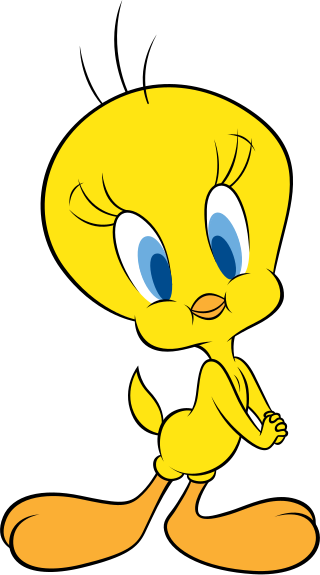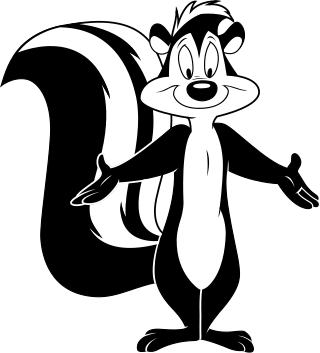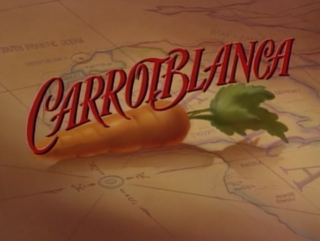
Looney Tunes is an American animated franchise produced and distributed by Warner Bros. It began as a series of short films that originally ran from 1930 to 1969, along with its spin-off series Merrie Melodies, during the golden age of American animation. Following a revival in the late 1970s, new shorts were released as recently as 2014. The two series introduced a large cast of characters, including Bugs Bunny, Daffy Duck, and Porky Pig. The term Looney Tunes has since been expanded to also refer to the characters themselves.

Tweety is a yellow canary in the Warner Bros. Looney Tunes and Merrie Melodies series of animated cartoons. His characteristics are based on Red Skelton's famous "Junior the Mean Widdle Kid." He appeared in 46 cartoons during the golden age, made between 1942 and 1964.

Sylvester J. Pussycat Sr. is a fictional character, an anthropomorphic cat in the Looney Tunes and Merrie Melodies series of cartoons. Most of his appearances have him often chasing Tweety Bird, Speedy Gonzales, or Hippety Hopper. He appeared in 103 cartoons in the golden age of American animation, lagging only behind superstars Bugs Bunny, Porky Pig, and Daffy Duck. Three of his cartoons won Academy Awards, the most for any starring a Looney Tunes character: they are Tweetie Pie, Speedy Gonzales, and Birds Anonymous.

Granny, whose full name is presented as Emma Webster, is a fictional character created by Friz Freleng, best known from the Looney Tunes and Merrie Melodies animated short films of the 1950s and 1960s. She is the owner of Tweety Bird and, more often than not, Sylvester and Hector. Her voice was first provided by Bea Benaderet from 1950 through 1955, then by June Foray for almost 60 years then Candi Milo took over in 2017 following Foray's death.

Pepé Le Pew is an animated character from the Warner Bros. Looney Tunes and Merrie Melodies series of cartoons, introduced in 1945. Depicted as a French anthropomorphic striped skunk, Pepé is constantly on the quest for love and pursuit of romance but typically his skunk odor causes other characters to run away from him.
Edward Selzer was an American film producer and publicist who served as head of Warner Bros. Cartoons from 1944 to 1958. The son of German Jewish immigrants, he was raised in NYC with his brother, then enlisted and served in the US Navy where he fought as a Golden Gloves boxer. He won a boxing exhibition for the Navy and was awarded with a weekend pass. While out on leave he met a New York chorus girl named Laura Cohn; he later married Laura in 1927 and relocated to Los Angeles where they had two children; Phyllis and Robert.

For Scent-imental Reasons is a 1949 Warner Bros. Looney Tunes short directed by Chuck Jones and written by Michael Maltese. The short was released on November 12, 1949, and featured the debut of Penelope Pussycat.

Tweety's High-Flying Adventure is a 2000 American animated musical slapstick comedy film produced by Tom Minton and James T. Walker, written by Tom Minton, Tim Cahill and Julie McNally, and directed by James T. Walker, Karl Toerge, Charles Visser, and Kyung Won Lim, starring Tweety.

Carrotblanca is a 1995 Looney Tunes cartoon short. It was originally shown in theaters alongside The Amazing Panda Adventure and The Pebble and the Penguin (internationally). It was subsequently released on video packaged with older Looney Tunes cartoons and was included in the special edition DVD. It was later released on HD DVD, Blu-ray, and iTunes releases of Casablanca, the film to which it is both a parody and an homage.

Bah, Humduck! A Looney Tunes Christmas is a 2006 animated direct-to-DVD Christmas comedy film starring the Looney Tunes characters, directed by Charles Visser, produced by Warner Bros. Animation and animated by Toon City Animation. The film is based on Charles Dickens' novella A Christmas Carol (1843). The special was released on DVD on November 14, 2006, and was then broadcast on Cartoon Network in December 2006. The special was rereleased on DVD as part of the Looney Tunes Holiday Triple Feature on September 1, 2020.
Louvre Come Back to Me! is a 1962 Warner Bros. Looney Tunes cartoon directed by Chuck Jones. The short was released on August 18, 1962, and stars Pepé Le Pew in his last cartoon of the "classic" Warner Bros. animation age.
Bugs Bunny's Easter Special is a 1977 Easter-themed Looney Tunes television special directed by Friz Freleng and features clips from 10 Warner Bros. cartoons. It originally aired on the CBS network April 7, 1977.
Scent-imental Romeo is a 1951 Warner Bros. Merrie Melodies animated short directed by Chuck Jones. The short was released on March 24, 1951, and stars Pepé Le Pew.
Who Scent You? is a 1960 Warner Bros. Looney Tunes cartoon directed by Chuck Jones. The short was released on April 23, 1960, and stars Pepé Le Pew and Penelope Pussycat.
Wild Over You is a 1953 Warner Bros. Looney Tunes short animated film directed by Chuck Jones. The short was released on July 11, 1953, and stars Pepé Le Pew.
Two Scent's Worth is a 1955 Warner Bros. Merrie Melodies short directed by Chuck Jones. The short was released on October 15, 1955, and stars Pepé Le Pew.

Odor-able Kitty is a 1945 Warner Bros. Looney Tunes cartoon directed by Chuck Jones. The short was released on January 6, 1945, and was the first appearance of the romantic skunk Pepé Le Pew.
A Scent of the Matterhorn is a 1961 Warner Bros. Looney Tunes cartoon written and directed by Chuck Jones. The short was released on June 24, 1961, and stars Pepé Le Pew.










